I didn’t want to imbue my statues with ideology

Download image
Jan Hendrych was born on 28 November 1936 in Prague into the family of the lawyer Jaroslav Hendrych and the sculptor Olga Hendrychová (née Tobolková). In the years 1951-1955 he attended the Secondary Technical School of Home Design; he then studied at the Academy of Art, Architecture & Design in Prague. He undertook mandatory military service as an assistant in the sculpting workshop of Zdeněk Němeček, who worked on state commissions at the time. In 1963-1966 he attended a postgraduate course at the Academy of Fine Arts. After the occupation in 1968, he was expelled from the Mánes Association of Fine Artists for his political opinions, and he was unable to exhibit his works during the normalisation. He earned a living restoring statues. The most notable work of this period is the reconstruction of the two sculptures by Theodor Friedl on the attic balustrade of the theatre in Karlovy Vary, which was a collaboration with Jiří Laštovička. He was not allowed to exhibit his own creations until 1988, in the Prague City Gallery. In 1990 the Academy of Fine Arts in Prague appointed him head of the Figurative Sculpting Studio. He also functioned as a guest professor at the Academy of Arts in Banská Bystrica, where he also led the sculpting studio from the year 2000. In 1993-1995 he served as deputy rector of the Academy of Fine Arts; he also had a brief tenure at the academy in Helsinki.

